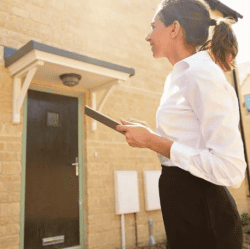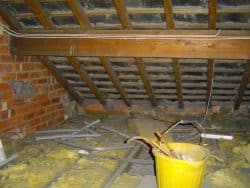Buying a home is an expensive business; what’s more, if you discover issues that need to be resolved after you have moved in, it can become even more expensive. This is why most house purchasers instruct a surveyor to conduct a survey on their chosen property. This will take place after their offer has been accepted and before they complete their purchase.
Your conveyancer may be able to recommend a local surveyor to you. Conveyancing specialists such as Sam Conveyancing will recommend that you select a surveyor who is a member of the Royal Institution of Chartered Surveyors (RICS), as they are professionally qualified and work to a recognised standard.
The job of a surveyor
A surveyor is a property expert who will inspect the property for you and provide a written report detailing any issues identified. There are four different types of survey to choose from with the one you choose dependent on your personal preference, your risk appetite, and the type of property you are buying.
As the surveyor has to visit the property, you should choose a local surveyor who is familiar with the type of property you are buying; for example, a surveyor from Cornwall is unlikely to be the best person to carry out a building survey in Bath.
Types of survey
There are four types of survey offered by the Royal Institution of Chartered Surveyors:

- RICS Home Survey – Level 1. This basic survey is appropriate for modern and conventionally built homes with no extensions and/or additions. It gives a traffic light rating for the different parts of the building, services and grounds, and a summary risk assessment. This survey is not particularly detailed and does not include any advice or valuations.
- RICS Home Survey – Level 2. This type of survey is most appropriate for conventional properties that are in a reasonable condition. It covers everything that a Level 1 survey covers; in addition, it includes a check of the roof spaces and cellars if they are present. This survey will also offer recommendations for further investigations, advice, and a basic budget for any maintenance that is required.

- RICS Home Survey – Level 2 with valuation. If a valuation is chosen to be included within a Level 2 survey, the surveyor will propose a market value for the property, an insurance reinstatement figure, and note any issues that could affect the value of the property.
- RICS Home Survey – Level 3. This is a full structural survey and is recommended for properties over 50 years old, where extensions or other modifications have been made, the property is listed, or the property is in a poor condition. This very thorough survey describes all the identifiable risks, the potential causes, and the potential hidden defects. It will recommend remedial work and the consequences of not carrying it out. It will also prioritise the required repairs and suggest indicative costs and timelines for the work to be completed.
Reasons for surveys
The main reason people choose to have a survey on a property they are buying is to reduce the risk of incurring extra costs for maintenance and repairs once they have moved in. The results of the survey can also be used to negotiate the price of the property if expensive repairs are required. A survey can sometimes be required by mortgage companies or for insurance purposes. You may wish to share the results of the survey with your conveyancer, especially if you plan to negotiate a reduction in the property price.
